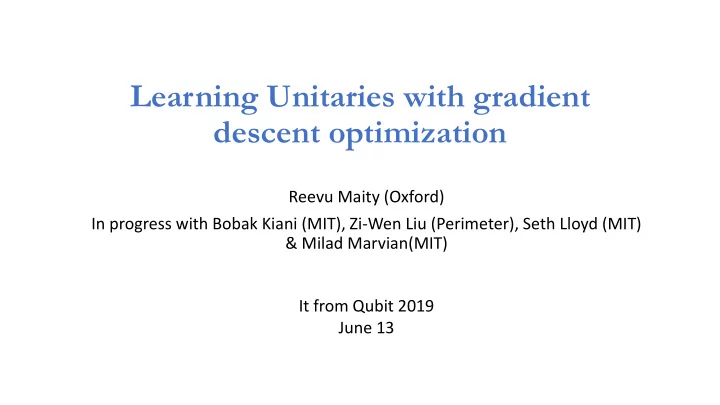

Learning Unitaries with gradient descent optimization Reevu Maity (Oxford) In progress with Bobak Kiani (MIT), Zi-Wen Liu (Perimeter), Seth Lloyd (MIT) & Milad Marvian(MIT) It from Qubit 2019 June 13
Outline • We consider classical optimization algorithms to learn / simulate parametrized unitary transformations generated by two Hamiltonians applied in alternation ( QAOA ). • Gradient Descent algorithms are first order classical methods widely studied in the machine learning community for convex optimization. • Recently, it was shown that QAOA can be used for universal quantum computation. S. Lloyd (2018) Any unitary can be simulated with parameters via the alternating operator method. S. Lloyd & RM (2019) • Aim : Study the learnability / simulability of unitaries under the alternating operator / QAOA formalism with gradient descent.
Problem QAOA Unitary : are random matrices of dimension sampled from the GUE and . Learning problem • Given access to a target unitary and knowledge of , can we simulate by a sequence using gradient descent on all parameters such that ? What is the time complexity = minimum number of parameters + total number of gradient descent steps ? • Suppose is a shallow depth unitary (say, depth-4 with parameters ), can we find a sequence such that ?
Non-Convex Optimization QAOA Unitary : • The space of the set of unitaries is in general non-convex. • Standard gradient descent algorithms do not converge in non-convex spaces. • Gradient descent usually gets stuck at some local critical point where .
Non-Convex Optimization • Second order optimization techniques (eg. Newton’s method : calculate Hessian and then it’s inverse) require, a) at least time for a Hessian matrix of dimension . b) fine tuning of hyperparameters. • Gradient descent methods can be powerful due to their computational efficiency from the above perspectives. Require time to calculate gradients for parameters, fine tuning not required. • Can gradient descent optimization enable us to learn paramterized/QAOA unitaries ?
Results so far QAOA Unitary : • We find that gradient descent optimization requires at least parameters in to approximate with accuracy .where is sampled from a parameter manifold of dimension . ≤ The rate of learning increases when gradient descent is done in overparametrized spaces with dimension . ≥ . However • We propose a greedy algorithm for learning low-depth in time ≪ the success probability of efficient learning in non-convex spaces is not ideal.
Gradient Descent Some basic equations for gradient descent optimization , • Loss function : = • Gradients : , • Learning rate : , fixed to a certain value during the entire iteration . e.g. = 0.001 • Parameter update : , Aim : Optimize to a desired accuracy .
Learning with gradient descent In this work, Loss Function : = . Aim : Learn to an accuracy . Simulations for 32 dimension target unitaries with or 512 parameters while varying the number of learning parameters in .
Gradient Descent Numerics A `transition ’ occurs when gradient descent is performed in the overparameterized domain, . The rate of learning increases as we do gradient descent on more parameters beyond .
Gradient Descent Numerics (Contd.) Underparametrized Overparametrized α = rate of learning For the first 200 gradient descent steps, Loss = κ (no. of grad. descent steps) −α The underparametrized models learn following a power law while the overparametrized models learn faster than the power law.
A Greedy Algorithm for low depth QAOA unitary Can we learn low depth with << parameters ? A layer = Pseudocode : Given access to with known . 1. 𝑏 0 = Initial Loss = . 2. Add a layer to with parameters . Cost function = . 3. Perform gradient descent on to obtain optimized . 𝑏 1 = Updated Loss = . and 𝑏 1 < 𝑏 0 . 4. Add a new layer with parameters to the layer in the previous step. Updated Cost function = . 5. Perform gradient descent on to obtain optimized 𝑏 2 = Updated Loss = and 𝑏 2 < 𝑏 1 . 6. Repeat the above for n steps till convergence i.e. 𝑏 𝑜 < ϵ .
Greedy Algorithm Performance Can we learn low depth with << parameters ? • Approximating with depth-4 corresponding to n = 2, 3, 4, 5, 6 qubits . • Succeeds in finding a sequence with at most 20-24 parameters and • Success probability of learning in non-convex spaces is not ideal , between 0.1 and 0.15 . • Usually gets stuck at some local critical point or saddle point .
Learning with random local circuits A general learning setting Motivation : Study many-body dynamics / MBL . Goal : Learn / Simulate with 𝑉 1 𝑊 1 𝑉 2 𝑊 2 … 𝑉 𝑂 𝑊 𝑂 without assuming knowledge of . 2 2 2 2 𝜐 3 𝜐 1 𝜐 2 𝜐 4 𝑊 2 2 2 2 𝑢 2 𝑢 1 𝑢 3 𝑉 2 , are random matrices sampled from GUE. 1 1 1 1 𝜐 1 𝜐 4 𝜐 2 𝜐 3 𝑊 1 Result : Simulates depth-4 when gradient descent is done on all parameters. 1 1 1 𝑢 1 𝑢 2 𝑢 3 𝑉 1 Can the local circuit model simulate low depth with << parameters ? Can it simulate 1 2 3 4 5 6 Haar random unitaries ?
Remarks QAOA Unitary : • Numerical simulations of the learnability of with at least parameters by gradient descent. • A greedy algorithm for simulating short depth with << parameters. Success probability is not ideal. In progress • A rigorous justification of the requirement of more than parameters for learning . Investigate the distribution of critical points in the loss function landscape. • A local circuit model algorithm that can efficiently simulate low depth with higher success probability than the greedy one. • Noise resilience of simulating constant depth QAOA unitaries in NISQ devices.
Recommend
More recommend